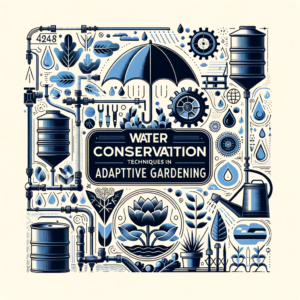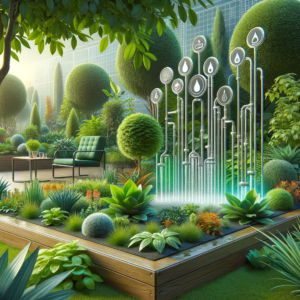In the evolving world of adaptive gardening, smart watering technologies are emerging as game-changers, offering unprecedented control, efficiency, and ease of use. These innovative systems are making garden maintenance more accessible and enjoyable for individuals of all abilities. This comprehensive guide explores the world of smart watering technologies and how they can transform adaptive gardens into thriving, low-maintenance oases.
Understanding Smart Watering Technologies
Smart watering technologies encompass a range of devices and systems that automate and optimize the watering process in gardens. These systems use sensors, weather data, and user inputs to make intelligent decisions about when and how much to water plants.
Key Concepts:
| – Internet of Things (IoT) connectivity |
|---|
- Real-time data analysis
- Automated decision-making
- Remote control and monitoring
Benefits for Adaptive Gardening
- Reduced Physical Effort: Minimizes the need for manual watering
- Improved Accessibility: Control from smartphones or voice-activated devices
- Water Conservation: Precise watering reduces waste
- Customized Care: Tailored watering schedules for different plant needs
- Time-Saving: Automates a time-consuming garden task
- Stress Reduction: Eliminates worry about under or overwatering
- Consistent Plant Care: Maintains optimal moisture levels even during absences
Types of Smart Watering Systems
- Smart Irrigation Controllers:
- Replace traditional timers with weather-based scheduling
- Adjust watering based on local weather conditions
- Soil Moisture Sensors:
- Monitor soil moisture levels in real-time
- Trigger watering only when necessary
- Smart Hose Timers:
- Upgrade existing hoses with smart capabilities
- Control via smartphone apps
- Fully Integrated Smart Garden Systems:
- Combine watering with other garden monitoring features
- Often include plant identification and care advice
- Smart Sprinkler Systems:
- Automate and optimize in-ground sprinkler systems
- Offer zone-based control for larger gardens
Key Features of Smart Watering Devices
- Wi-Fi Connectivity: Allows for remote control and monitoring
- Smartphone Apps: User-friendly interfaces for system management
- Weather Integration: Adjusts watering based on forecasts and real-time weather
- Zone Control: Customizes watering for different garden areas
- Water Usage Reports: Tracks and analyzes water consumption
- Voice Control: Compatible with smart home assistants for hands-free operation
- Leak Detection: Alerts users to potential system issues
- Scheduling Flexibility: Allows for complex, plant-specific watering schedules
Installation and Setup Process
- Choose the Right System: Select based on garden size and complexity
- Plan the Layout: Determine sensor and controller placement
- Install Hardware: Mount controllers and place sensors
- Connect to Wi-Fi: Ensure stable internet connection
- Download and Setup App: Follow manufacturer’s instructions for app setup
- Create Watering Zones: Define areas with similar watering needs
- Set Initial Schedules: Program basic watering routines
- Fine-tune Settings: Adjust based on plant responses and seasonal changes
Integrating with Existing Garden Systems
- Compatibility Check: Ensure new smart systems work with existing irrigation
- Gradual Integration: Start with one zone or area before expanding
- Unified Control Systems: Look for platforms that can manage multiple garden technologies
- Sensor Integration: Add soil moisture or weather sensors to existing setups
- Smart Home Ecosystem: Connect with broader home automation systems
Customization and Programming
- Plant-Specific Settings: Tailor watering to individual plant needs
- Seasonal Adjustments: Program changes for different times of year
- Vacation Modes: Set special routines for when you’re away
- Water Budgeting: Set limits on water usage
- Custom Alerts: Create notifications for specific conditions
- Learning Algorithms: Some systems adapt over time based on plant response
Maintenance and Troubleshooting
- Regular Software Updates: Keep system firmware and apps current
- Sensor Cleaning: Periodically clean soil moisture sensors
- Battery Checks: Replace batteries in wireless components as needed
- Connectivity Issues: Troubleshoot Wi-Fi connection problems
- Calibration: Occasionally recalibrate sensors for accuracy
- Winter Preparation: Protect outdoor components in freezing climates
Cost Analysis and ROI
- Initial Investment: Higher upfront costs compared to traditional systems
- Water Savings: Significant reduction in water bills over time
- Energy Efficiency: Less power used for pumping and distribution
- Plant Health Improvements: Reduced losses from improper watering
- Time Savings: Less time spent on manual garden maintenance
- Longevity: Quality systems can last for many years with proper care
Environmental Impact
- Water Conservation: Dramatically reduces water waste
- Reduced Runoff: Minimizes water pollution and soil erosion
- Energy Savings: Lower water pumping needs
- Chemical Reduction: Optimal watering can reduce the need for fertilizers and pesticides
- Biodiversity Support: Allows for efficient care of diverse plant species
- Education: Increases awareness of water usage and conservation
Future Trends in Smart Garden Watering
- AI Integration: More sophisticated learning and prediction capabilities
- Advanced Sensors: Improved accuracy and additional data points (e.g., soil nutrients)
- Drone Technology: Aerial monitoring and targeted watering
- Greywater Integration: Smart systems that incorporate household greywater
- Predictive Maintenance: Systems that anticipate and prevent issues
- Increased Accessibility: More features for users with various disabilities
Conclusion
Smart watering technologies are revolutionizing the way we approach garden care, making it more accessible, efficient, and enjoyable for gardeners of all abilities. These systems not only conserve valuable resources but also provide a level of precision and convenience that was previously unattainable in home gardening.
For those with adaptive needs, smart watering technologies offer the freedom to maintain a thriving garden with minimal physical effort. The ability to control and monitor garden watering remotely opens up possibilities for individuals who may have found traditional gardening challenging.
As these technologies continue to evolve, we can expect even more innovative solutions that will further enhance the adaptive gardening experience. By embracing smart watering systems, gardeners can create beautiful, sustainable landscapes that flourish with less effort and more joy.
FAQ
- Q: Can smart watering systems work without an internet connection? A: Many systems have offline modes, but full functionality often requires internet connectivity for weather data and remote control.
- Q: How do smart watering systems handle power outages? A: Most systems have battery backups to retain settings, and some can operate basic functions without power.
- Q: Are smart watering systems difficult to install for someone with limited mobility? A: While some systems are DIY-friendly, professional installation is recommended for complex setups or for users with mobility challenges.
- Q: Can these systems detect and alert me about plant diseases? A: Some advanced systems with camera integration can identify signs of plant stress or disease, but this is not a standard feature in all smart watering systems.
- Q: How do smart watering systems account for rainfall? A: Many systems use local weather data or rain sensors to automatically adjust watering schedules when it rains.



